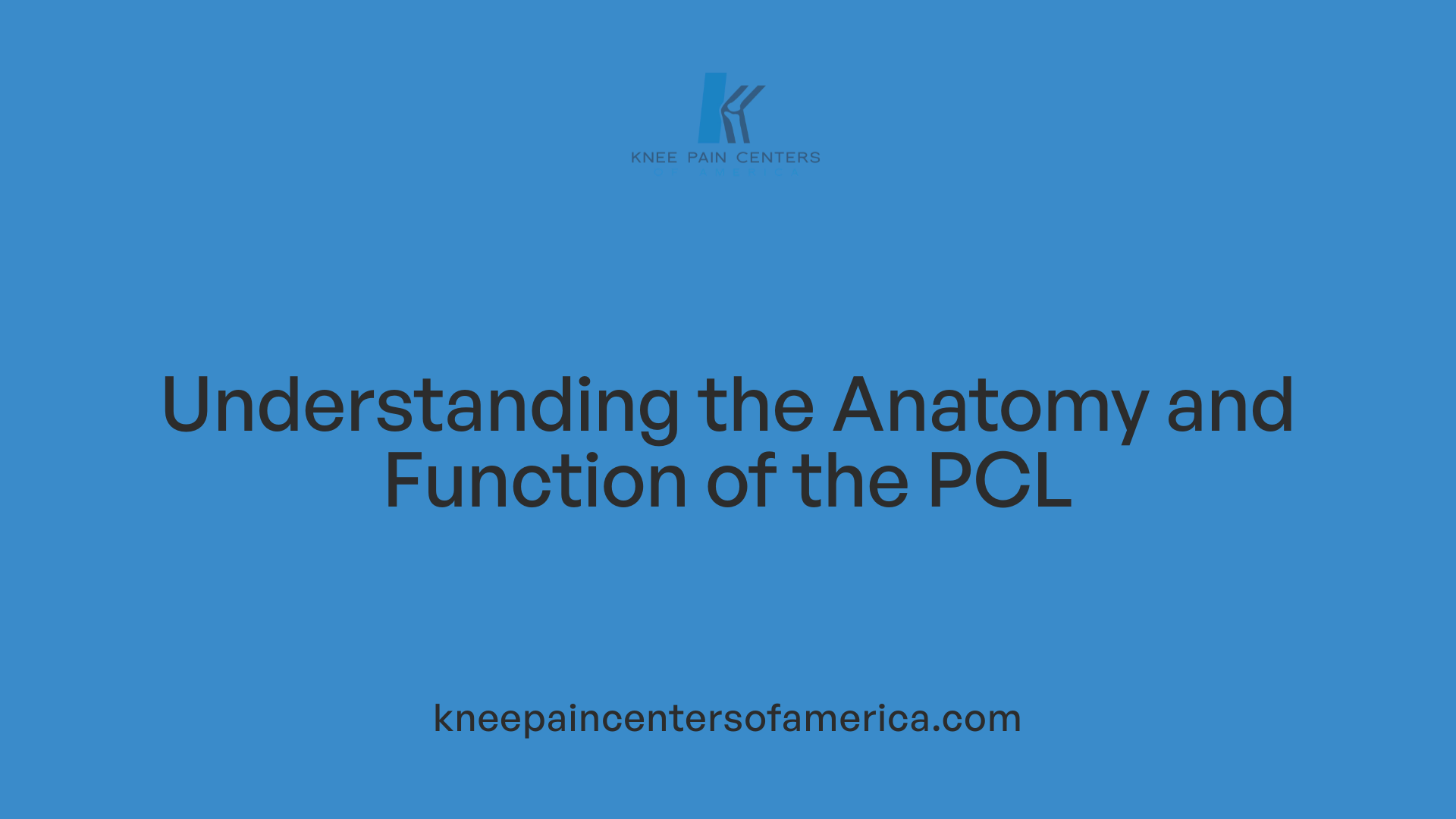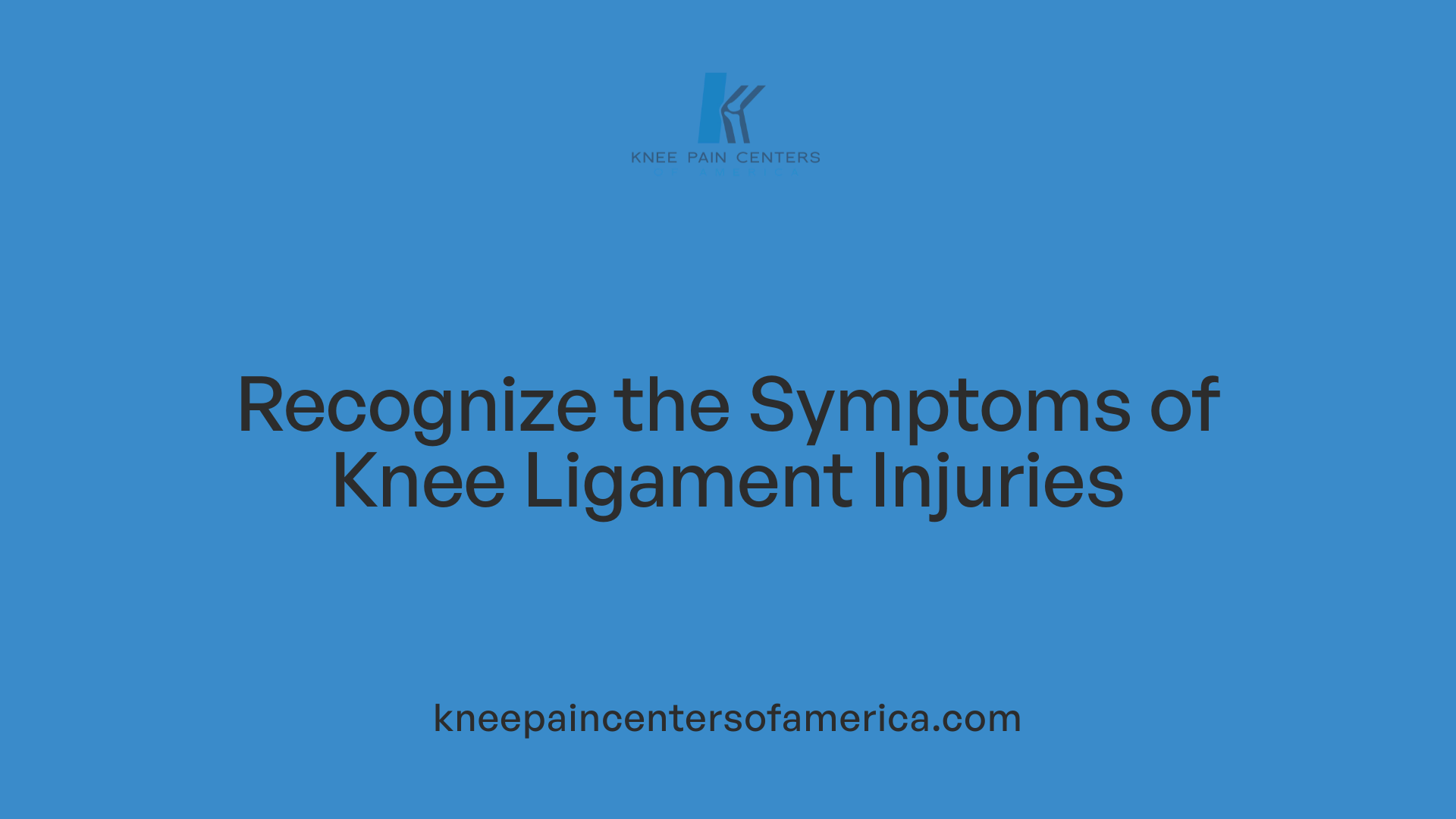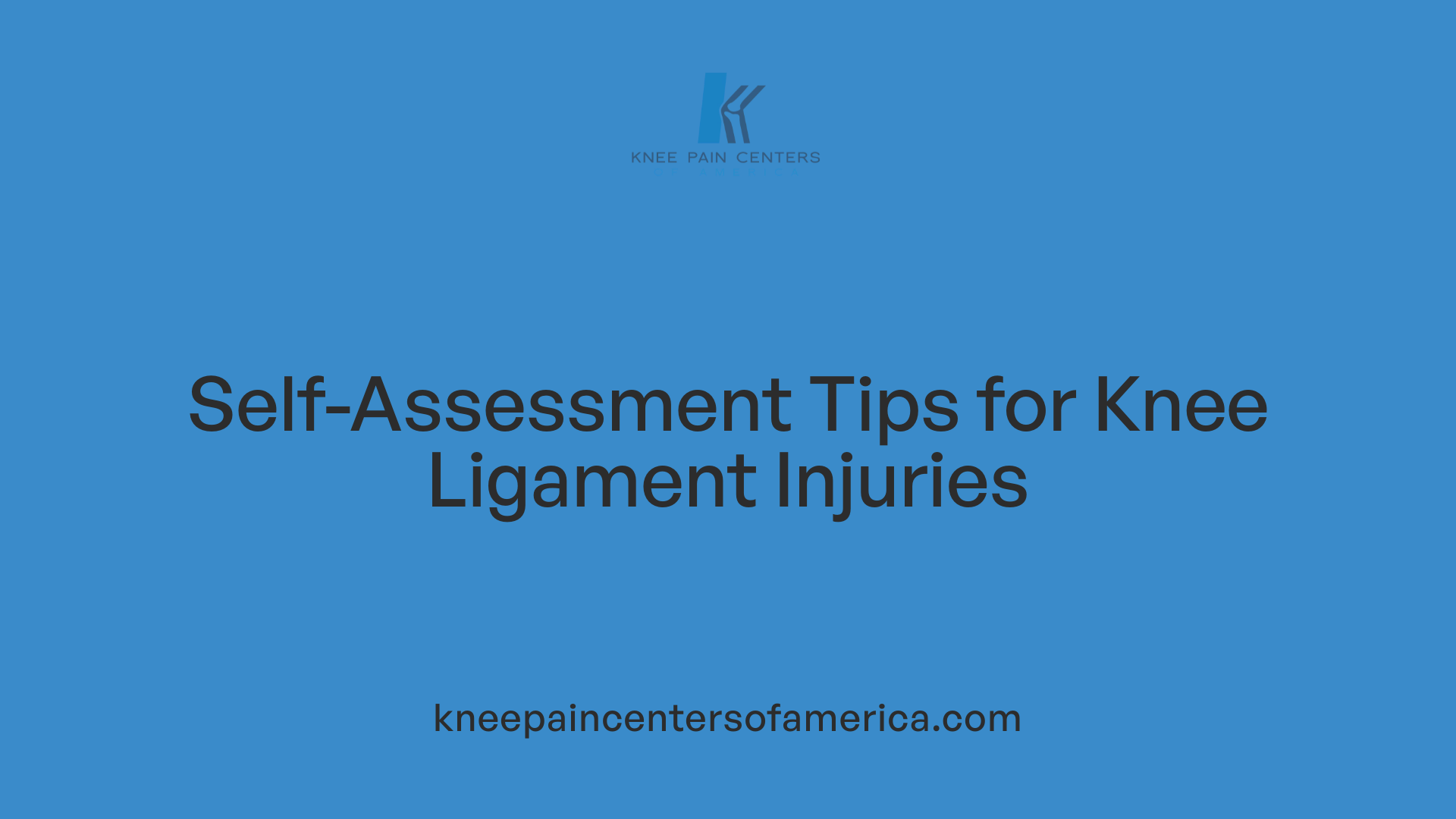Navigating Knee Injuries: A Guide to PCL Tears and Self-Checks
Knee injuries, especially to the posterior cruciate ligament (PCL), are common among athletes and active individuals. Recognizing the symptoms early and understanding how to perform basic self-assessment tests at home can be crucial for prompt treatment and recovery. This article explores the signs of PCL tears, how you can check for these injuries safely, and when to seek medical help.
Overview of the PCL and Its Role in Knee Stability

What is the anatomy of the PCL?
The posterior cruciate ligament (PCL) is one of the four main ligaments in the knee. It is located at the back of the knee joint and connects the femur (thigh bone) to the tibia (shinbone). The PCL is a strong, band-like structure that crosses over the anterior cruciate ligament (ACL), creating a crucial stabilizing structure in the knee.
What is the function of the PCL?
The primary role of the PCL is to keep the tibia from sliding backward under the femur. It also helps stabilize the knee during movement, especially when the knee is bent. The PCL works together with other ligaments to provide rotational stability and prevent excessive movements that might damage the joint.
What are the common injuries involving the PCL?
PCL injuries typically occur during sports or activities involving sudden stops, pivots, or direct impacts to the front of the knee. Individuals involved in sports like football, basketball, or skiing are more prone to PCL tears. Traumatic incidents such as falls onto a bent knee or a direct blow to the shin when the knee is flexed can cause the ligament to tear or stretch.
What are the symptoms of a PCL tear?
The symptoms usually develop gradually or immediately following injury. Common signs include pain that worsens over time, swelling and inflammation behind the knee, and a sensation that the knee might give out or buckle. Many people experience stiffness, difficulty walking, or climbing stairs because of joint instability and pain. Tenderness and swelling tend to appear behind the knee, and some report warmth or bruising in the region. Severe injuries can cause a feeling of the knee buckling or make weight-bearing difficult.
Understanding the anatomy and functions of the PCL helps in recognizing injuries early and seeking appropriate treatment. Proper diagnosis and management are essential for restoring knee stability and preventing long-term joint problems.
Symptoms Indicating a Knee Ligament Injury

What are the symptoms of a PCL tear?
A torn posterior cruciate ligament (PCL) often presents with a range of symptoms that can vary in intensity. Immediately following the injury, individuals might experience sharp pain and a popping sound at the time of injury. Over time, the pain may worsen or persist, especially during movement.
Swelling and inflammation typically develop around the back of the knee, making the joint appear puffed or swollen. This swelling can also cause a feeling of stiffness or reduced flexibility. Many patients report a sensation that the knee is unstable or giving way, particularly when walking or bearing weight.
The injury often results in difficulty walking or climbing stairs due to joint instability and pain. Tenderness is commonly felt behind the knee, and some individuals notice warmth or bruising in that area. Severe cases might cause the knee to buckle or feel like it is about to give out, complicating mobility.
Symptoms to Watch For
- Pain that worsens over time or with movement
- Swelling and signs of inflammation
- Instability or buckling of the knee
- A loud pop at the moment of injury
- Difficulty walking or bearing weight
Recognizing these symptoms early and seeking professional evaluation can prevent further damage. Imaging tests like X-rays or MRI scans, combined with physical assessments, help confirm the diagnosis and guide effective treatment plans.
Why Professional Diagnosis Matters
While some initial symptoms are visible and noticeable, only a healthcare professional can accurately determine the extent of the ligament damage. Proper diagnosis ensures appropriate treatment, helping minimize long-term issues and stabilize the knee for recovery.
Performing Basic Home Tests for Knee Ligament Assessment

How can I self-assess for a PCL injury at home?
Self-assessment for a PCL injury can be attempted through simple physical tests and careful observation of symptoms. One common method is the Posterior Drawer Test. To perform this, lie on your back with your knee bent at around 90 degrees. Gently push the tibia (shinbone) backward. If the tibia slides more than normal or there is excessive movement compared to the unaffected knee, it could suggest a PCL tear.
In addition to the Posterior Drawer Test, paying attention to signs like swelling, knee instability, difficulty straightening or bending the knee, and the feeling that the knee may give way can help you identify potential injury. You might also notice severe pain when moving the knee, popping sounds during injury, or an inability to bear weight.
While these methods can give some indication of a possible issue, they are not conclusive. Professional diagnosis by a healthcare provider, including physical exams and imaging tests like MRI or X-ray, is essential for an accurate assessment.
Meanwhile, using the RICE method—Rest, Ice, Compression, and Elevation—can help reduce swelling and prevent further damage. If symptoms are severe or worsening, it’s crucial to seek immediate medical attention to ensure proper treatment and recovery planning.
Differences Between Professional and Home Ligament Tests

What are the differences between professional knee ligament tests and home self-assessment methods?
Professional knee ligament examinations, such as the Lachman test, anterior drawer test, and pivot shift test, are performed by trained healthcare providers. These tests are designed to accurately assess the integrity of knee ligaments and stability by using precise maneuvers. For example, the Lachman test involves gently pulling the tibia forward while stabilizing the thigh to detect ligament laxity, which indicates a tear. The pivot shift test assesses knee stability by rotating and shifting the joint to observe any subluxation or instability.
These assessments rely heavily on the practitioner's experience and technique. They often include palpation and careful observation of subtle signs, making them highly reliable for diagnosing injuries. Additionally, clinicians usually complement physical tests with imaging tools like MRI or X-rays to confirm the extent of the ligament tear.
In contrast, home self-assessment methods are usually simple and less reliable. Common approaches include observing swelling, testing range of motion, or noting symptoms such as pain or knee instability. Some individuals might perform basic tests, like trying to walk on the affected knee or testing for a “popping” sensation, but these are not as systematic or precise.
The limitations of home assessments are significant. They can suggest whether there might be a problem but cannot definitively diagnose ligament tears. Without the nuanced evaluation a professional exam provides, there's a risk of missing or misinterpreting injury severity.
Imaging plays a crucial role in confirming ligament injuries. MRI scans are especially useful for visualizing ligament tears, detecting associated injuries like meniscus tears, and planning appropriate treatment. While home tests can be helpful for initial screening, especially if severe symptoms like swelling or instability are present, they should not replace professional diagnosis.
In summary, professional ligament tests are more accurate and comprehensive, utilizing specialized techniques and tools. Home assessments are useful for early symptom recognition but lack the specificity needed for an accurate diagnosis, underscoring the importance of consulting healthcare providers for proper evaluation.
Recovery Timeline and When to Seek Medical Intervention

How does the severity of a PCL injury influence recovery?
The recovery time for a PCL tear varies significantly based on the injury’s severity. Mild injuries, often classified as Grade 1 sprains, involve slight ligament stretching and usually heal within 10 days to two weeks when the patient follows proper rest, ice, compression, and elevation (RICE) techniques. Moderate injuries may require three to four weeks of dedicated physical therapy to regain full knee function.
Severe PCL tears, especially those that involve complete ligament rupture, often necessitate surgical intervention. Full recovery from surgery can take anywhere from six to nine months, depending on factors like the patient’s age, activity level, and adherence to rehabilitation protocols.
What are initial management strategies?
Initial management focuses on controlling pain, swelling, and preventing further damage. Applying ice, resting the knee, and using crutches or a brace are essential in the early phase. Following the RICE method helps reduce swelling while protecting the knee.
During the acute phase, reducing weight-bearing activities is crucial. Once swelling decreases, gradual physical therapy begins, emphasizing range-of-motion exercises, strengthening, and proprioceptive training.
Who is eligible for conservative treatment?
Conservative treatment may be appropriate for mild PCL injuries where the ligament is stretched but not torn completely. Patients who experience knee stability and have minimal swelling often recover well without surgery. Wearing a knee brace, engaging in physical therapy, and avoiding high-impact activities can suffice for mild cases.
However, severe tears or cases with significant instability usually require surgical repair or reconstruction for optimal recovery.
Why is professional diagnosis critical?
While initial home assessments, including simple movement tests, can provide helpful clues about ligament injury, professional diagnosis is essential. Orthopedic specialists perform thorough physical examinations and may utilize imaging tests like X-rays or MRIs to evaluate the extent of damage.
Misdiagnosing or delaying treatment can lead to chronic instability, cartilage damage, or long-term arthritis. Early intervention ensures targeted treatment, better outcomes, and a faster return to normal activity.
| Aspect |
Details |
Why It Matters |
| Symptoms |
Swelling, pain, instability |
Guides diagnosis and treatment choices |
| Diagnosis Methods |
Physical assessment, imaging |
Ensures accurate identification |
| Treatment Approaches |
RICE, physical therapy, surgery |
Determines recovery plan |
| Recovery Period |
Weeks to months |
Sets patient expectations |
Understanding the differences in injury severity, adhering to early management strategies, and seeking professional advice are vital steps toward effective recovery from a PCL tear.
When to Seek Professional Help for Knee Injuries
While simple self-assessment can help identify potential PCL injuries, it is essential to seek prompt medical evaluation if symptoms are severe, swelling is significant, or instability is experienced. Accurate diagnosis often requires physical examinations by healthcare professionals and imaging tests like MRI. Early intervention improves recovery prospects and reduces the risk of long-term damage. Do not delay consulting an orthopedic specialist if in doubt or if symptoms worsen.
References